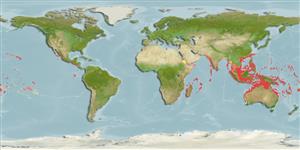>
Acanthuriformes (Surgeonfishes) >
Acanthuridae (Surgeonfishes, tangs, unicornfishes) > Acanthurinae
Etymology: Acanthurus: Greek, akantha = thorn + Greek, oura = tail (Ref. 45335).
More on author: Linnaeus.
Issue
Planes and Fauvelot (2002) studied Acanthurus triostegus over its vast range and published in the journal Evolution and they did not recognize Acanthurus triostegus sandvicensis as a species. FishBase follows Randall, 1956 with A. sandvicensis as a subspecies (synonym) of A. triostegus.
Environment: milieu / climate zone / depth range / distribution range
Écologie
marin récifal; profondeur 0 - 90 m (Ref. 9710), usually 0 - 90 m (Ref. 27115). Tropical; 26°N - 36°S, 25°E - 85°W (Ref. 57245)
Indo-Pacific: throughout the region except for the seas around the Arabian Peninsula. Eastern Pacific: lower Gulf of California to Panama, including the Revillagigedo, Cocos, Clipperton, and Galapagos islands.
Length at first maturity / Taille / Poids / Âge
Maturity: Lm 8.8 range ? - ? cm
Max length : 27.0 cm TL mâle / non sexé; (Ref. 3145); common length : 17.0 cm TL mâle / non sexé; (Ref. 9267)
Épines dorsales (Total) : 9; Rayons mous dorsaux (Total) : 22 - 26; Épines anales: 3; Rayons mous anaux: 19 - 22. Body olivaceous gray, with 4 vertical stripes (1 stripe on head across the yellow eye; 1 on caudal peduncle); shading to white ventrally, often with a sharp line of demarcation. Sharp, forward-pointing, erectile spine on each side of caudal peduncle which folds down into a groove. Scales minute. Teeth with denticulations on sides and top. Gill rakers 18-22 in anterior row, 19-24 in posterior row.
Adults occur in lagoon and seaward reefs with hard substrate; young abundant in tide pools (Ref. 3145, 48637). Benthopelagic (Ref. 58302). Often feeding near freshwater run-offs where certain algae grow on rocks that are grazed (Ref. 48637). Occasionally form schools; feed on filamentous algae in large aggregations. During spawning, clouds of eggs and sperm are preyed upon by eagle rays which are often present during spawning. Form spawning aggregations (Ref. 27825). Size of metamorphosis from post-larva stage to juvenile is 3.2 cm (Ref. 9267). Utilized as a food fish (Ref. 7364). Minimum depth reported taken from Ref. 27115.
Form spawning aggregations (Ref. 27825).
Randall, J.E., 1956. A revision of the surgeonfish genus Acanthurus. Pac. Sci. 10(2):159-235. (Ref. 1920)
Statut dans la liste rouge de l'IUCN (Ref. 130435)
Menace pour l'homme
Reports of ciguatera poisoning (Ref. 4690)
Utilisations par l'homme
Pêcheries: commercial; Aquarium: Commercial
Outils
Articles particuliers
Télécharger en XML
Sources Internet
Estimates based on models
Preferred temperature (Ref.
123201): 23.4 - 28.9, mean 27.6 °C (based on 2614 cells).
Phylogenetic diversity index (Ref.
82804): PD
50 = 0.5000 [Uniqueness, from 0.5 = low to 2.0 = high].
Bayesian length-weight: a=0.02399 (0.01950 - 0.02951), b=2.96 (2.92 - 3.00), in cm total length, based on LWR estimates for this species (Ref.
93245).
Niveau trophique (Ref.
69278): 2.8 ±0.35 se; based on food items.
Generation time: 3.1 ( na - na) years. Estimated as median ln(3)/K based on 2
growth studies.
Résilience (Ref.
120179): Milieu, temps minimum de doublement de population : 1,4 à 4,4 années (K=0.35; tm=1-2).
Fishing Vulnerability (Ref.
59153): Low vulnerability (16 of 100).
Climate Vulnerability (Ref.
125649): Low to moderate vulnerability (29 of 100).
Nutrients (Ref.
124155): Calcium = 71.8 [30.1, 215.7] mg/100g; Iron = 0.884 [0.331, 2.244] mg/100g; Protein = 18.5 [17.4, 19.6] %; Omega3 = 0.128 [0.057, 0.283] g/100g; Selenium = 23.5 [8.3, 74.2] μg/100g; VitaminA = 32.8 [8.6, 116.6] μg/100g; Zinc = 2.55 [0.81, 4.65] mg/100g (wet weight);
